Converging Technologies for Improving Human
Performance
Cat: ECO
Pub: 2002
#: 0215b
National Science Foundation & Department
of Commerce
Edited by Mihail C. Roco and William Sims Bainbridge, NSF
02531u/18203r
Title
Converging Technologies for Improving Human Performance
人間能力改善のための収斂技術
Author
NSF and DOC
NSFおよび米国商務省
Published
June 2002
2002年6月
Index
Why?
-
This report incorporates the view expressed at
the workshop of leading experts on Dec. 3-4, 2001.<
-
The "convergent technologies" refers
to the synergistic combination of four major "NBIC"
(Nano-Bio-Info-Congo) provinces of science and technology.
-
>Activities that accelerate convergence to improve
human performance must be enhanced, and a holistic approach to
monitor the resultant societal evolution.
-
Major Themes:
-
Converging technologies:
to improve human performance, as well as overall potential
for changing economy, society and research needs.
- Expanding human cognition& communication:
to understand the structure, function, and potential enhancement
of human mind, personal sensory device interface
- Improving human health:
nano-bio processor for R&D, nanotechnology based implants,
nanoscale robots, brain-brain and brain to machine interfaces
- Enhancing group outcomes:
remove barriers caused by physical disabilities, language differences,
and variation of knowledge
- National Security:
response to chemical, biological, radiological and explosive
threats
- Unifying science and education:
New curriculum, new concepts to provide intellectual coherence,
and new forms of educational institution
- The recommendations of this report are far-reaching and fundamental,
urging the transformation of science, engineering and technology;
in five topical groups: a) individuals, b) academe, c) private sector,
d) government, e) professional societies, f) other organization
(NGO)
-
本報告書は,2001年12月3-4日に米国の専門家会議による見解に基づいている。
-
収斂技術とは、 "NBIC" (ナノ-バイオ-情報-認知科学)の主な4分野の科学技術共同研究によるシナジー効果をいう。
-
収斂技術を進展させる諸活動は、人間の力を増大させ、結果として社会進歩を示す総合的なアプローチとなる。
-
主なテーマとして
-
収斂技術
人間の作業改善し、経済・社会・研究対象の全面的な改革
- 人間の認知および通信
構造・機能を解明し、精神・感覚のインターフェイス向上
- 健康増進
研究開発のナノテク・バイオプロセッサ、ナノテクベースの臓器移植、ナノテクロボット、頭脳間、頭脳・機械間インターフェイス
- グループの成果拡大
物理的な身体障害、言語の相違、知識レベルの相違による障壁の除去
- 国家安全
化学・生物・放射能・爆発物の脅威への対応
- 科学・教育の統合
新カリキュラム、知的統一性提供の新概念、教育制度の新構築
- 本報告は基本的なものであり、個人、学会、企業、政府、専門家、NGOなど諸組織において、科学、技術の根本的な変革を要請するものである。
Summary
要約
>Top 1. Overview:
- We stand at the of a New Renaissance in science and technology.
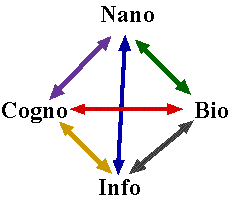 NBIC tetrahedron (Fig.1)
NBIC tetrahedron (Fig.1)
- Fig. 1 shows NBIC tetrahedron, in which each field is represented
by a vertex, each part of fields by a line, each set of three fields
by a surface, and the entire union of all by the volume of the tetrahedron.
- The unification of science and technology is achievable over the
next two decades.
- NBIC convergence can enhance human mental, physical, and social
abilities. Better understanding of the human body and development
of tools for direct human-machine interaction have opened completely
new opportunities.
- The hallmark of the Renaissance was its holistic quality;
art, engineering, science and culture shared the same exiting
sprit and many of the same intellectual principles. However
institutions such as universities, corporations and government
agencies proliferated bureaucratic units, the holism of the
Renaissance gave way to specialization and intellectual fragmentation.
- It is time to rekindle the sprit of the Renaissance, returning
to the holistic perspective on a higher level, with a new set
of principles and theories.
- >Top 20 convergent technologies:
- Broad-bandwidth interfaces directly between human brain and
machines.
- Comfortable, wearable sensors and computers
- Robot and software agents
- New knowledge and skills learnt by people from all background
and all ranges of ability.
- Effectiveness of groups, multinational partnerships
- Human body; being healthy, energetic, easier to repair, resistant
to stress, biological threat, and aging process
- Machines and structures; of stronger materials, adapt to changing
situations, high energy efficiency, and environmental friendliness.
- Technologies and treatments; compensate for physical and mental
disabilities
- National security by light-weight information-rich war fighter
systems
- Instantaneous access to needed information from anywhere
- new tools and improved understanding of wellsprings of human
creativity
- ability to control the genetics of humans, animals, and plants
- robot construction of extraterrestrial bases of Moon and Mars
- fast & reliable communication
- enabling far better adjustment, creativity, and daily decision
making for the average person
- intelligent environments for both mass production and costume
design.
- Agriculture; greatly increase yields and reduce spoilage
- Safe, cheap, and fast transportation
- Work of scientists will be revolutionized
- Formal education will be transformed by a unified but diverse
curriculum
1. 概観:
- 我々は、いま科学技術の新たなルネサンスの入口に立っている。
- NBIC 四面体(左図)
- 左図の四面体の頂点が、ナノ、バイオ、情報、認知科学の各分野、線は2つの分野の組合せ、面は3つの分野の組合せ、全体の体積は4つの分野の組合せを表現している。
- 科学技術の統合は今後20年間(~2020)に実現される見込み。
- NBICの収斂は人間の精神、身体、社会的能力を増大させる。人間の身体への理解、マンマシン相互作用の道具の開発は、全く新しい機会を切り開く。
- ルネサンスの特質は、その全体論(holism) にある。芸術、技術、科学、文化は同じような高揚する精神や知的原理の多くを共有していた。しかしやがて大学、企業、政府機関が官僚的な組織を拡大させ、ルネサンスの全体論は、専門分化の流れに道を譲ることになった。
- いまやルネサンスの精神を再燃させ、あらたな原理と理論を伴ったさらに高いレベルでの全体論的な展望に戻るべき時である。
- 20の収斂技術:
- 頭脳・機械間の広帯域インターフェイス
- 快適なウェアラブル・センサー
- ロボット、ソフトウェア・エージェント
- 各分野の専門家による新知識・スキル
- グループ効率、多国籍パートナーの効率
- 健康、修復可能、耐ストレス・老化防止
- 強化素材、エネルギー効率、環境にやさしい機械や構築物
- 障害者のための技術と治療
- 光技術、IT活用軍事技術
- 世界どこからでも情報にアクセス可能
- 創造力発揮のための解析と新ツール
- 人間、動植物遺伝子コントロール
- 月や火星への到着、基地建設
- 高速、高信頼性のコミュニケーション
- 創造力、決断支援システム
- 大量生産やカスタムデザインのためのインテリジント環境
- 農業生産拡大
- 安価・安全・高速な交通手段
- 科学研究の革命的向上
- 教育カリキュラムの変化
>Top 2. Converging Technology:
For example;
- Cognitive neuroscience:
fMRI (functional magnetic resonance imaging:
- The smallest structure in the brain that can routinely be
imaged: about a cubic millimeter in size, but contain tens of
thousands of neurons
- Software efficiency;
has not improved at anything like the rate of hardware.
- Biocomputing and cognitive science; growing understanding
of the neural architectures and algorithms actually employed
by the human brain
- Bio-nano processor;
- for programming complex biological pathways on a chip that
mimic cellular processes
- Complementarity of the four areas:
- If the Cognitive Scientists can think it
- the Nano people can build it
- the Bio people can implement it, and
- the IT people can monitor and control it.
- New areas:
new areas are likely to emerge that have not yet attracted the attention
of many scientists and engineers.
- Work efficiency:
Convergent technology has the potential to provide better value
to customers at lower cost to producers.
- Custom-design craftsmanship (maximizes customer satisfaction)
with the principles of assembly-line mass production (minimizes
production costs)
- >Top Mental Health:
The most difficult challenge we face in improving human performance
is mental illness.
- Nano-technology will deliver medications to the exact location
within the brain.
- Space Flight:
- Nanostructured materials will reduce the weight of spacecraft
by 3/4. Durable but light and self-reparing spacesuits; subsystems
with low demands for electric power.
- Intelligent machine, or "humanity" far into space
will be descendants of Pathfinder and the Voyagers.
- Food & Farming:
- nanoscale genetics may help preserve and control food production.
- Distributed sensors could advise about need for water and
fertilizer.
- Sustainable & Intelligent Environments:
- Durable house paints that change color, reflecting or absorbing
heat.
- Indoors, ordinary walls could be vast computer displays.
- Adaptive materials: thermocouples, or piezoelectric rather than
requiring electric input.
- Self-presentation & Fashion:
- Wearable computers; packaged in scintillating jewelry, communicating
thought and feelings between people.
- Smart clothing adjustable to the wearer's activities and social
environment.
- Transformation of Civilization:
- new ethical principles will govern in areas of radical technological
advance: brain implants, political rights for robots
- New professions for humans and new roles for machines.
- >Top History of human performance:
Generations
Key Advancement
Cell, body & brain development
-100,000
Paleolithic, Homo Electus, speech
-10,000
Homo Sapiens, making tools
-500
Mesolithic, creating art
-400
Neolithic, agriculture, writing,
libraries
-40
Universities
-24
Printing
-16
Renaissance, accurate clock
-10
Industrial revolution
-5
Telephone
-4
Radio
-3
TV
-2
Computers
-1
Microbiology, Internet
0
Nanoscience, Biotechnology,
Global connection via Internet
1/2
Nanoscale conversing technologies
improving human performance advancements
Global education
1
Converging technology products:
new products/services, brain connectivity, etc.
n
Evolution transcending human
cell, body, and brain
2. 収斂技術:
例えば、
- 認知神経科学:
fMRI:
- 現在の対象の組織は1立方ミリ。この中に数十万のニューロンを含む
- ソフトウェアの効率:
ハードウェアほど進歩していない
- バイオコンピューティングと認知科学: 実際の大脳の神経構造とアルゴリズムを理解
- バイオ・ナノプロセッサ
- 細胞プロセスを真似る生物経路をチップ化する
- 4分野の補完関係:
- 認知科学が考え、
- ナノ技術が製作し
- バイオ技術が実行し
- IT技術が監視・制御する
- 新分野:
従来注目された来なかった新分野の開発
- 生産性向上:
比較的低価格での新たな価値を提供
- カスタム設計で顧客満足を、アセンブルラインの大量生産で生産コスト削減する
- 精神的健康:
精神病治療は最も困難な分野
- ナノテクノロジーによって大脳内の正確な部位に薬剤投与する
- 宇宙飛行:
- ナノ技術により宇宙船の重量の3/4を削減。丈夫・軽量・自動修復の宇宙服、省電力機器
- コンピュータによる大脳のシミュレーションが可能になると、人工大脳は発見のツールとなる
- 知的機械による宇宙遠方への知性派遣(PathfinderやVoyagersの後継)
- 食糧・農業
- ナノスケール遺伝学による食糧生産の保存と管理
- 分散センサーにより水・肥料の必要性を把握
- 持続的なインテリジェント環境
- 熱の反射・吸収を行う色変化塗料
- 内装では、通常の壁面を巨大ディスプレイに
- 適応素材:熱電対、圧電により電力供給不要素材
- ファッション:
- ウェアラブル・コンピュータ;宝石、感情コミュケーション機能付
- スマート・クロージング;行動や環境にフィットした調整機能付
- 文明の変化:
- 急成長分野での新たな倫理観
大脳移植、ロボットの政治的権利など
- 人間の新たな職業、機械の新たな役割
- 人類のパフォーマンスの歴史:
<左図>
>Top 3. Age of transition:
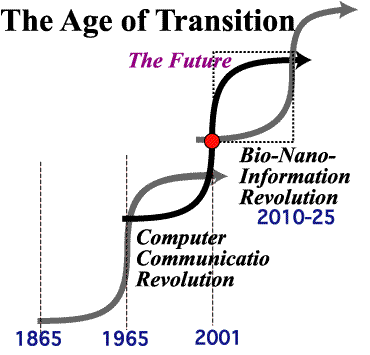 Theme a Summary:
Theme a Summary:
- Revolutionary technological change tends to occur outside
conventional organizations.
- We are in an Age of Transition
- Government agencies need progress in NBIC.
- Scientist should take great intelligent risks, exploring unusual
and even unreasonable ideas.
- >Top The role of OSTP (Office of Science and Technology Policy);
is to identify crosscutting, high-risk technologies that don't reside
in a particular department or agency and to sponsor them.
- Scientists have an obligation as citizens to go out and explain
what they need and what their work will mean.
- If we want this economy to grow, we have to be the leading scientific
country in the world.
- We are living through two tremendous patterns of scientific-technological
change; an overlapping of a computer-communications revolution and
a nonotechnology-biology-information revolution.
- At a minimum, we need to double the federal research budget
at all levels, reform science and math learning decisively,
and modernize our systems of health, learning, and government
administration.
- "Nano" is the space in which quantum behavior begins
to replace the Newtonian physics; means one-billionth of a meter
and is usually used in reference to a nanosecond. Nanotechnology
"grows" materials by adding the right atoms and molecules.
- It may possible to grow carbon storage tubes so small that
hydrogen could be safely stored without refrigeration, thus
enabling the creation of a hydrogen fuel cell technology.
- Imagine a carbon tube 100 times as strong as steel and
only one-sixth as heavy.
- We may be able to develop anticancer molecules that penetrate
cells without damaging them and hunt cancer at its earliest
development.
- The Human Genome project will teach us more about humans than
our total knowledge to this point.
- It is the synergistic effect of these three systems (Nano-Bio-Information)
that will lead to an explosion of new knowledge and new capabilities
and create intersecting S-curves.
- >Top 18 Characteristics of an Age of Transition:
- Cost will crash.
- Systems will be customer-centured and personalized.
- 24-7 will be the world of the future.
(e-customers, then e-voters)
- Convenience will be a high value.
- Convergence of technologies will increase convenience, expand
capabilities, and lower costs.
- Processes will be expert system-empowered.
- Middlemen will disappear.
- Changes can come from anywhere.
- Resources will shift from opportunity to opportunity.
(There are countless efforts to reform and modernize bureaucracies,
but that is exactly the wrong strategy.)
- The rapid introduction of better, less expensive products will
lead to continual replacement.
- The focus will be on success.
(Venture capitalists praise those who take risks, even if they
fail, over those who avoid risks, even if they avoid failure.)
- Venture capitalists and entrepreneurs will focus on opportunities.
(It it he nature of politics and government to focus on problems
when the real breakthroughs come from focusing on opportunities.)
- Real breakthroughs will create new products and new expectations.
- Speed matters; new things will need to get done quickly.
("Launch and learn" than "study and launch")
- Start small but dream big.
- Business-to-business is the first big profit opportunity.
- Applying quality and lean thinking can save enormous amounts.
- Partnering will be essential.
3. 変化の時代:
- 総括テーマ:
- 革命的な技術変化は従来の組織の外側で起こる傾向がある
- 我々は変化の時代にいる。
(左図参照)
- 政府機関はNBICの推進すべきである。
- 科学者は大いなる知的リスクを取り、奇抜な、そして理不尽とも言えるアイデアを探索すべき。
- 科学技術政策局(OSTP)の役割:
省庁管轄に限定されない複合的、ハイリスクな技術を特定し、それを支援する。
- 科学者達は市民として外にでて、何が必要で、彼らの仕事が何を意味するのか説明する義務がある。
- もしこの国の経済を成長させたいなら、世界での科学をリードする国にならねらばならない。
- 我々は科学技術の2つの領域での変化に遭遇している。コンピュータ・通信革命とナノテク・バイオ・情報革命である。
- 少なくとも、連邦の研究予算をすべての分野で2倍にし、科学・数学教育を改革し、医療・教育・行政システムの近代化すべき。
- ナノの空間ではニュートン力学に代わって量子力学のふるまいが起こる。ナノとは十億分の一の世界でそこではナノ秒が支配する。ナノテクは原子や分子を適切な一に加えることが進歩させる技術である。
- 例えば、カーボンストーレッジチューブによって水素を液化せずに貯蔵することが可能になるかも知れず、それは水素燃料セル技術の創造につながる。
- カーボンチューブは鋼鉄の100倍も強靱で、その1/6の重さしかない。
- 抗ガン分子を開発できれば、それは体細胞を傷つけずに進入でき、初期段階のガン細胞を叩くことができるようになる。
- ヒトゲノムプロジェクトによって我々は人間について、今までの知識を凌駕する知識が得られる。
- この3領域(ナノ・バイオ・情報)のシナジー効果によって、新知識や新能力の爆発を引き起こし進歩のS字曲線の交差を創り出すことができる。
- 変化の時代の18項目の特質:
- 価格破壊
- 顧客中心システム
- 24時間サービス
- 統合ワンクリックサービス
(e-customerからe-voterへ)
- 諸技術の収斂
- エキスパートシステム連携
- 中間業者の消滅
- 誰もが変化を作り出す
- 資源は新規機会へシフト
(官僚組織の改革への努力は間違った戦略である。)
- 良質・廉価な製品が早期に登場し代替えする
- 成功することに集中する
(ベンチャー資本はたとえ失敗を避けたとしてもリスクを回避した人よりも、たいとえ失敗してもリスクを取った人を称賛する。)
- ベンチャー資本と起業家は機会に着目する
(政治や政府は問題箇所に注目するが、真のブレイクスルーは機会の所に注目することから始まる)
- 真のブレイクスルーは新たな製品と新たな期待を創り出す
- スピードが重要
(研究してから開始よりは、まず開始しそれから学べ)
- 小さく開始し、夢は大きく
- まずB2Bに大きな機会がある
- Quality and lean thinking応用による無駄の排除
- 官民パートナーシップ
>Top 4. NASA's Nanotechnology Initiative:
- NASA's mission:
- Space and Earth science
- Biological and Physical Research (BPR)
- Human Exploration and Development of Space (HEDS)
- Aeronautics and space systems
- The current state-of-the-art microelectronics is rapidly approaching
its limit (0.1 microns):
- Nanotechnology will afford a new class of electronics.
- Use of carbon nanotubes, nano-phase materials, and molecular
electronics.
- Carbon nanotubes: 100x the strength of steel;
could reduce the weight of launch vehicle by half.
- nanometer-scale carbon wire: 10,000x better current than
copper.
- "Small but powerful" to its extreme limits
- >Top Biology:
selectivity and sensitivity at a scale of a few atoms;
- massively reproduce with near-zero error rates
- self-assembly into highly complex systems
- adapt form and function to changing conditions
- detect damage and self repair
- communicate among themselves
- Data storage based on DNA will be a trillion times more
dense than current media
- Supercomputers modeled after the brain: as little as a
billionth of the power of existing designs
- Nano-scale, bio-compatible sensors can be distributed
throughout the body
4. NASAのナノテク戦略:
- NASAのミッション:
- 宇宙・地球科学
- 生物物理調査(BPR)
- 人間探求・宇宙開発(HEDS)
- 航空・宇宙システム
- 現在の最新のマイクロエレクトロニクスは急速に限界に近づいている(0.1ミクロン)
- ナノテクは新たなエレクトロニクス領域
- カーボンナノチューブ、ナノフェーズ素材、分子エレクトロニクス
- カーボンナノチューブ:鋼鉄の100倍の強度。打ち上げ物体の重量を半減できる
- ナノスケールのカーボンワイヤー:銅線より1万倍の伝導率
- 限界までの「微少かつ強靱性」
- 生物学:数原子のレベルでの選択性と感度
- エラーほぼゼロでの大量再生産
- 高度複雑システムの自己組み立て
- 条件変化に対応した形態と機能
- 損害の検出と自己修復
- 仲間間での通信
- DNAレベルでのデータ貯蔵は従来メディアの1兆倍
- 大脳モデルのスーパーコンピュータ:現在の設計より十億分の1に小型化
- ナノスケールの体内適応センサーを体中に配置
>Top 5. The Impact of the Big O's:
- "The Big O's": nano, bio, info,
and cogno
- Greatest engineering achievements of 20th century:
1
Electrification
11
Highway
2
Automobile
12
Spacecraft
3
Airplane
13
Internet
4
Water supply
14
Imaging
5
Electronics
15
Household appliances
6
Radio & TV
16
Health technologies
7
Agricultural mechanization
17
Petroleum technologies
8
Computer
18
Laser & Fiber optics
9
Telephone
19
Nuclear technologies
10
Air conditioning & Refrigeration
20
High-performance materials
- >Top Health technologies is No.16; NBIC technology could focus on this
field in this century and help move it into the top ten.
- The Congressional legislative process is quite effective for targeting
priorities.
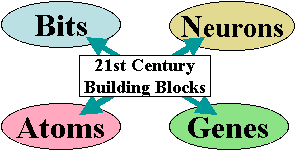 The power tools of the 21st century:
The power tools of the 21st century:
Will we be ready to adapt to this pace of change?;
Need to bridge the gap between policy and the fast-changing global
market economy may be critically important to the nation's future
prosperity and global leadership.
- Internet traffic doubles every 6 months;
- wireless capacity doubles every 9 months;
- optical capacity doubles every 12 months;
- storage doubles every 15 months;
- chip performance doubles every 18 months (Moore's Law)
- 21st century's building blocks - bit, atoms, genes and neurons.
- NNI (National Nanotechnology Initiative)
5. 4つのBig Oのインパクト:
- 4つのBig Oとは、nano, bio, info, and cogno
- 20世紀の偉大な工業化達成番付
(左図)
- 医療技術は左図の表の第16位。NBIC技術はこの分野に注目し、21世紀には10位以内になるようにする。
- 米国議会の立法措置は優先度を決める意味で重要。
- 21世紀の強力な道具:
我々はこの変化のペースに対応可能か?
政策と急激に進歩するグローバル市場とのギャップを埋めることは、国家の興隆とグローバルなリーダシップにとって重要。
以下倍増に要する月数:
- インターネットトラフィックは6ヶ月毎
- 無線能力は9ヶ月毎
- 光ファイバ容量は12ヶ月毎
- ストーレッジは15ヶ月毎
- チップ能力は18ヶ月毎 (ムーアの法則)
- 21世紀のビルディングブロック
(左図参照)
- Info: ビット
- Nano:原子
- Bio:遺伝子
- Cogno:ニューロン
>Top 6. Coherence and Divergence of Megatrends:
- Six Increasingly Interconnected Megatrend:
- Information&
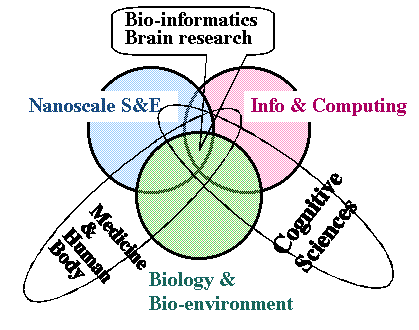 Computing:
Computing:
bit-based language has allowed us to expand communication, visualization,
and control beyond our natural intellectual power.
- Nanoscale science & Engineering:
Working at atomic, molecular, and supramolecular levels allows us
to reach directly the building blocks of matter beyond our natural
size limitation on orders of magnitude smaller than what we can
see, feel, or smell.
- >Top Biology and Bioenvironmental approaches:
One important aspect is genetic engineering, another is the connection
between life and its environment.
- Medical sciences and enhancement of the human body:
This includes monitoring health, enhancing sensorial and dynamic
performance, using implant devices, and extending capabilities by
using human-machine interfaces.
- Cognitive sciences and enhancement of intellectual abilities:
This area is concerned with exploring and improving human cognition,
behavior, and intellect. Enhancing communication and group interaction
are an integral part of improving collective behavior and productivity.
- >Top Collective behavior & systems approach:
This area uses concepts found in architecture, hierarchical systems
, caos theory, and various disciplines to study nature, technology,
and society.
- Science & Engineering (S&E) megatrends as related to human
representation:
Left-brain focus
Right-brain
focus
S&E trend
DNA, cell
Biosystems, organisms
Modern biology
Atom, molecule
Patterns, assemblies
Nanoscale S&E
Bits
visualization, networking
Info & computing
- Left-brain;
tends to favor reductionist analysis and depth in a single field,
which may contribute to "divergent" advancements.
- Right-brain;
tends to favor the "whole think" approach, and to assemble
the global vision for each initiative and see the coherence among
initiatives.
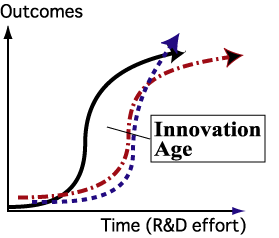 Pasteur's Quadrant: (Cf: right figure)
Pasteur's Quadrant: (Cf: right figure)
- More funds in industry are dedicated to funding development
and applied research.
Government needs to direct its funding more on complementary
aspect; fundamental research and mission-oriented projects that
encourage depth of understanding, synergism, and collaboration
among fields.
- "Innovation Age":
Organizations will change the focus from repetitive to creative,
innovation-based activities, and transfer efforts from machines
to human development.
6. メガトレンドの統一と分散:
(左図参照)
- 6つの共通領域のメガトレンド:
- 情報・コンピューティング:
ビッドベース言語によって、通信、視聴覚、制御の知的能力拡大
- ナノスケール科学・エンジニアリング:
原子、分子、分子上のレベルでの操作によって我々の知覚できないような微少のオーダーでの物質の組立が可能
- 生物学・生物環境的アプローチ:
一つの重要な領域は遺伝子エンジニアリング、もう一つは生命と環境との関連分野である。
- 医療科学・人体エンハンスメント:
健康状態の観察、感覚や動的能力のエンンハンス、移植機器の使用、マンマシンインターフェイスによる能力拡大などの分野を含む。
- 認知科学・知的活動エンハンスメント:
人間の認知、振る舞い、推論能力改善。コミュニケーションやグループでの反応を高めることは集団行動や生産性
- 集団行動・システムアプローチ:
アーキテクチャ、階層システム、カオス理論、自然・技術・社会研究の諸分野
- 人間の表現に関連したS&E:
(左表参照)
- 左脳:
還元主義的な分析、特定分野での深化を好む傾向を示し、拡散的な進展に寄与する。
- 右脳:
全体思考を好む傾向があり、個々のイニシアチブをグローバルな視点で集合し、統一性を志向する。
- パスツールの4象限:(以下図)
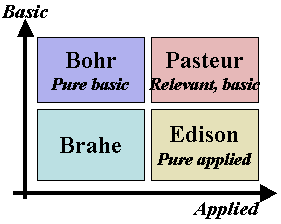
- 産業界では、開発や応用研究分野に多くの資金投入。
政府はこの補完的な分野として、基礎研究や知識やシナジー効果分野、協同作業分野の深化のためのプロジェクトへ資金投入すべきである。
- イノベーション時代の特徴:
(左図参照)
組織としては、繰り返し的なものから創造的・発明ベースの活動に注目し、機械に対するよりも人間の開発に注力するようになる。
>Top 7. Expanding Human Cognition & Communication:
- Five main areas in which integration of the NBIC sciences can
enhance the cognitive and communicative aspects of human performance.
- The Human Cognome Project:
- It is time to launch a Human Cognome Project, comparable to
the successful Human Genome Project, to chart the structure and
functions of the human mind.
- Complete mapping of the connections in the human brain, it would
be far more extensive than neuroscience.
- Human mind was not merely the result of brain evolution but
also required substantial evolution in culture and personality.
- At the very least, greater understanding of the human mind would
allow engineers to design technologies that are well suited to
human control and able to accomplish desired goals most effectively
and efficiently.
- >Top Personal Sensory Device Interfaces:
- Human senses are notoriously limited. Whereas we can hear ten
octaves of musical tones, we can see only one octave of the colors
of light, and our ears have a poor ability to form detailed "images"
from sound the way our eyes can with light.
- Today's communication technology has revolutionized the ability
of people to communicate across large distances, but little has
been done to help with small area communication, for example,
between individuals in a conference room.
- Research can develop sensory substitution techniques that transform
one type of input (visual, aural, tactile) into another, effective
means for storing memory external to the brain, knowledge-based
information architectures that facilitate understanding.
7. 人間の認知・コミュニケーションの拡大:
- NBIC科学の統合によって、人間の認知およびコミュニケーション能力に関する5つの領域。
- ヒューマン認知プロジェクト:
- ヒューマンゲノムプロジェクトに模して、ヒューマン認知プロジェクトを立ち上げ、人間の精神の構造と機能の地図を作成する。
- 大脳の完全な接続状態の地図を作るとしても、神経科学を遙かに凌駕するものとなる。
- 人間の精神は大脳の進化の結果のみならず、文化や個性の進化を獲得した結果でもある。
- 最低限として、人間の精神への深い理解によって人間が管理しやすく、またより効果的・効率的に目的を達成するような技術の設計に役立つ。
- 感覚デバイスインターフェイス:
- 人間の感覚はひどく限定的なものである。音楽の楽譜では10オクターブも聴けるのに、光の波長では1オクターブが見えるに過ぎない。また耳は目ができるような詳細なイメージを、音の場合にイメージを形づけることがまずできない。
- 今日の通信技術は、長距離を隔てた通信に革命を起こしたが、会議室における個々人のコミュニケーションのような至近距離での通信はほとんど進歩がない。
- ある一つの感覚(視覚、聴覚、触覚)の入力を他の感覚に代替する技術、記憶を大脳外に蓄積する効果的な方法、理解を助けるための知識ベースの情報アーキテクチャなど開発されよう。
>Top
- Enriched Community:
- Over the next two decades, PDAs are likely to evolve into smart
portals to a whole world of information sources, acting as context
aware personal brokers interaction with other systems.
- Today's email and conference call systems could evolve into
multimedia telepresence communication environments.
- GPS units could become comprehensive guides to the individual's
surroundings.
- Learning How to Learn:
- We need to explore fresh instructional approaches; as interactive
multimedia, graphical simulations, and game-like virtual reality
will enhance learning throughout the entire life.
- New, dynamic ways to represent mathematical logic could be
developed based on a correct understanding of how the human
mind processes concepts like quantity and implication, allowing
more people to learn mathematics more quickly, thoroughly, and
insightfully.
- The social interaction resulting from multi-user video games
can be harnessed as a strong learning motivator, if they are
designed for the user's demographic and cultural background.
- Enhanced Tools for Creativity:
- As technology becomes ever more complex, engineering design
becomes an increasingly difficult challenge.
- Biologically inspired techniques, such as evolutionary design
methods analogous to genetic algorithms, are especially promising.
- National center should be established for high-end engineering
design simulations.
- New developments in such areas as visual language, personalized
design, designing around defects, and the cognitive science
of engineering could be extremely valuable
- コミュニティのエンリッチ化:
- 今後20年間に内に、PDAは世界の情報源へのスマートポータルに進化し、他システムとのやり取りができる文脈を解する個人秘書として機能することだろう。
- 今日の電子メールや会議システムはマルチメディア・テレプレゼンス通信環境への進化するだろう。
- GPs端末は、個人の周辺情報への普遍的なガイドになっていくだろう。
- 学ぶことを学ぶ:
- 我々はまったく新しい教育手法、つまり双方向マルチメディア、グラフィカル・シミュレーション、ゲームのような仮想現実などのように、生涯を通じて教育を向上させるような仕組みを開拓すべきである。
- 数学的論理を表現するような新たなダイナミックな方法を開発すべきである。これはいかに人間の精神が数値や推論のような概念を処理するのか究め、より多くの人々に数学をもって早く完全に深く理解できるようにする方法である。
- ゲームのユーザの世代や文化的背景を考慮してデザインすることによって、マルチユーザのビデオゲームを通じた社会的なやりとりが、強力な学習動機として組み込まれることになる。
- 創造力強化ツール:
- 技術が一層複雑になることによって、エンジニアリングデザイン分野はますます困難な仕事となる。
- 生物にヒントを得た技術、遺伝子のアルゴリズムを模した進化の設計方法などは特に有望な分野である。
- ハイエンドのエンジニアリングデザインのシミュレーションのために国立のコンピュータセンタを作るべきである。
- ビジュアル言語、パーソナライズドデザイン、欠陥を取り巻くデザイン、エンジニアリングに関する認知科学は非常に価値が高い。
Comment
- Still contiune various reports of conversion of NBIC technologies.
- Paradignm change occurs and accelarate sharply when a certain
target was established. At the time of Renaissance, and of the Industrial
Revolution, similar inflation occured.
- After the exlosion of bandwidth, we are rushing into the age
of "explosion of knowledge."
- This report seems to proclaim this exlosion of knowledge as
'New Renaissance.'
- まだNBIC技術収斂の資料は続く。
- パラダイムの変化は、ある方向が見えだした時に、革命的に一気に加速すると思う。ルネサンスの時も、産業革命の時もそうであった。帯域の爆発の後には、そのコンテンツたる「知の爆発」の時代に突入しようとしているのではないか。
- 本レポートは、New Renaissanceとして、この知の爆発を宣言しているように思える。
Converging Technologies for Improving Human Performance |
Cat: ECOPub: 2002#: 0215b |
|
National Science Foundation & Department
of Commerce
|
02531u/18203r |
Title |
Converging Technologies for Improving Human Performance |
人間能力改善のための収斂技術 |
|---|---|---|
Author |
NSF and DOC | NSFおよび米国商務省 |
Published |
June 2002 |
2002年6月 |
Index |
||
Why? |
|
|
Summary |
要約 |
>Top 1. Overview:
|
1. 概観:
|
>Top 2. Converging Technology:For example;
|
2. 収斂技術:例えば、
|
>Top 3. Age of transition:
|
3. 変化の時代:
|
>Top 4. NASA's Nanotechnology Initiative:
|
4. NASAのナノテク戦略:
|
>Top 5. The Impact of the Big O's:
|
5. 4つのBig Oのインパクト:
|
>Top 6. Coherence and Divergence of Megatrends:
|
6. メガトレンドの統一と分散:(左図参照)
|
>Top 7. Expanding Human Cognition & Communication:
|
7. 人間の認知・コミュニケーションの拡大:
|
>Top
|
|
Comment |
|
|